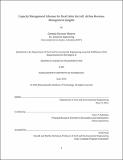Capacity management schemes for dual cabin aircraft : airline revenue management insights
Author(s)
Escovar Álvarez, Germán
DownloadFull printable version (2.971Mb)
Alternative title
Airline revenue management insights
Other Contributors
Massachusetts Institute of Technology. Department of Civil and Environmental Engineering.
Advisor
Peter P. Belobaba.
Terms of use
Metadata
Show full item recordAbstract
The selection of an aircraft type has long term effects on the competitive position of the airline. In a market that is continuously evolving, such as the commercial aviation industry, any degree of flexibility for adjusting an aircraft capacity to match better the demand provides an opportunity for airlines to remain profitable when conditions have changed. This thesis focuses on airlines operating dual cabin aircraft (premium and economy cabins) and explores two alternatives that can be used to adjust the capacity made available to maximize revenues. On the one hand, an easily implementable strategy of premium cabin capacity sharing is proposed with the intention of allowing passengers booking in economy fare classes to be accommodated in premium cabin seats when these seats are expected to be empty. On the other hand, a medium to long-term solution of changing the aircraft configuration (through aircraft replacement or retrofit) is considered. Both alternatives are tested using simulation tools that incorporate revenue management concepts and passenger decision making. Four heuristics are developed and tested to evaluate premium cabin capacity sharing. Based on the simulations, it is found that the methodologies proposed can generate total revenue gains of up to 1.1%. Nevertheless, two caveats are identified: first, losses in the revenue captured from premium fare classes are likely to be experienced due to displacement by economy fare class passengers. Second, premium cabin capacity sharing should only be implemented in the final stages of the booking process; otherwise, the sharing heuristics could result in revenue losses for the airline. With respect to cabin configuration analysis, an analytical model based on the Boeing-Swan Spill Model (BSM) is applied to dual cabin aircraft and is used to estimate the impacts on revenue due to a change in configuration. These results are compared to the results of the simulations and it is found that the BSM is able to predict in most cases whether the configuration change will generate revenue gains or losses for the airline. However, estimates of the dual cabin BSM ignore the interaction between passengers of both cabins, leading to incorrect estimates of load factors and average revenue values of spilled or accommodated passengers.
Description
Thesis: S.M. in Transportation, Massachusetts Institute of Technology, Department of Civil and Environmental Engineering, 2016. This electronic version was submitted by the student author. The certified thesis is available in the Institute Archives and Special Collections. Cataloged from student-submitted PDF version of thesis. Includes bibliographical references (pages 175-176).
Date issued
2016Department
Massachusetts Institute of Technology. Department of Civil and Environmental EngineeringPublisher
Massachusetts Institute of Technology
Keywords
Civil and Environmental Engineering.